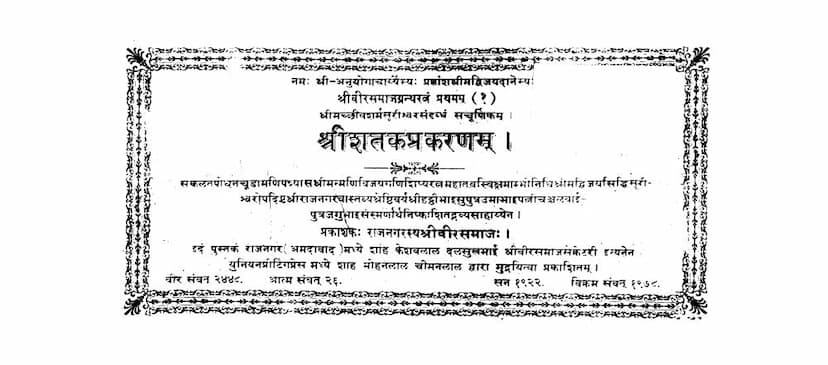Shatak Prakaranam
Added to library: September 2, 2025

Summary
This is a comprehensive summary of the "Shatak Prakaranam" based on the provided text and catalog link:
Book Title: Shatak Prakaranam Author: Veer Samaj (as credited in the provided text) Publisher: Veer Samaj (as credited in the provided text) Catalog Link: https://jainqq.org/explore/034183/1
Overall Summary:
The "Shatak Prakaranam" is a Jain text authored by Veer Samaj, published by the same. The text itself appears to be a commentary or explanation of a work titled "Shatak Prakaranam," originally composed by Shree Chashamsurishwarji and later elaborated upon by Shree Vijay Siddhinsuri. The commentary is attributed to Shree Maneklal Umasavaji. The book was published in Rajnagar (Ahmedabad) in Veer Samvat 2448 (corresponding to 1922 AD and Vikram Samvat 1978).
The text delves into intricate details of Jain philosophy, specifically focusing on the karmas (actions and their consequences) and their influence on the soul's journey through the cycle of birth and death (samsara). It systematically explains the principles of bandha (bondage of karma), udaya (manifestation of karma), udīraṇā (premature manifestation of karma), and pudgala (matter) as understood in Jainism.
Key Themes and Concepts Covered:
-
Introduction and Purpose: The text begins with auspicious salutations and explains its purpose: to guide beings towards liberation (moksha) by elucidating the nature of karma and its causes. It highlights that understanding the soul's qualities, karma's bondage, its experience, and its cessation are crucial for achieving this.
-
Structure and Terminology: The book defines its own structure, stating it will cover aspects like karmaprakṛti (types of karma), bandhavidhāna (rules of bondage), and karma-yoga (the process of karma). It uses specialized Jain terminology like jīvasthāna (states of the soul), guṇasthāna (stages of spiritual development), upayoga (consciousness/attention), yoga (sense-activity/mental and physical actions), bandha (bondage), udaya (fruition), udīraṇā (emission), samayoga (combination), pachaya (cause/reason), bandhavidhāna (method of bondage), prakṛtibandha (bondage of type), sthiti bandha (bondage of duration), anubhāga bandha (bondage of intensity), and pradeśa bandha (bondage of extent).
-
Classification and Analysis of Karma:
- Jīvasthāna and Guṇasthāna: The text meticulously details the fourteen jīvasthānas (based on senses and mind) and the fourteen guṇasthānas (stages of spiritual progress), explaining how different karmas apply and are experienced at each stage.
- Upayoga (Consciousness): It elaborates on the twelve types of upayoga (sensory and mental consciousness, divine knowledge, telepathic knowledge, omniscience, and their respective perceptions).
- Yoga (Activity): It describes the fifteen types of yoga (five types of mental, four types of speech, and seven types of bodily activities).
- Bandha (Bondage): The core of the text is dedicated to the four types of karma bondage:
- Prakṛti Bandha (Type Bondage): The nature of the karma itself.
- Sthiti Bandha (Duration Bondage): The period for which the karma remains attached.
- Anubhāga Bandha (Intensity Bondage): The potency or strength of the karma.
- Pradeśa Bandha (Extent Bondage): The amount of matter attached to the soul.
- Causes of Karma: It identifies the primary causes of karma bondage as mithyātva (false belief), asaṃyama (lack of self-control), kaṣāya (passions like anger, pride, deceit, greed), and yoga (activities).
- Time Period of Karma: The text discusses the duration of karmic bondage, differentiating between prāgbandha (initial bondage), sthiti (duration), anubhāga (intensity), and prakṛti (type). It also details the concept of āyuṣka karma (lifespan karma) and its specific durations.
- Specific Karma Analysis: The book provides detailed classifications and causes for various karmas, including:
- Ghatiya Karmas (Deluding Karmas): Jñānāvaraṇīya (knowledge-obscuring), Darśanāvaraṇīya (perception-obscuring), Mohaṇīya (deluding), and Antarāyīya (obstruction).
- Aghatiya Karmas (Non-deluding Karmas): Vedanīya (feeling-producing), Āyuṣka (lifespan), Nāma (body-making), and Gōtra (status-determining).
- Pudgala and Karma: It explains how pudgala (matter) binds with the soul to form karma, detailing the process of matter's transformation based on its qualities and the soul's activities.
-
Stages of Spiritual Development and Karma: A significant portion of the text is dedicated to the interplay between the fourteen guṇasthānas and the experienced karmas. It explains how the intensity and type of karma change as the soul progresses through these stages, from the deepest ignorance to omniscience and liberation.
-
Causes for Different Karma Durations and Intensities: The text meticulously analyzes the specific actions, mental states, and spiritual practices that lead to different durations and intensities of karmic bondage. This includes discussions on bhūyaskāra (increase), alpatara (decrease), avatta (fixed), and avaktavya (inexpressible) aspects of karma.
-
Subha (Auspicious) and Aśubha (Inauspicious) Karmas: The text distinguishes between auspicious and inauspicious karmas based on their causes (purity vs. impurity of mind and actions) and their eventual outcomes.
-
Commentary and Interpretation: The text includes a detailed commentary ("Churni") that clarifies complex verses and philosophical points, citing other Jain scriptures and traditions for support.
Overall Significance:
The "Shatak Prakaranam," through its detailed commentary, serves as a profound guide for understanding the complex mechanisms of karma in Jainism. It emphasizes that through right knowledge, right faith, and right conduct, coupled with careful observation of one's actions and their underlying motivations, an individual can mitigate the negative impacts of karma and progress towards spiritual liberation. The text highlights the importance of understanding the subtle nuances of soul-matter interaction and the role of various stages of spiritual development in this process.